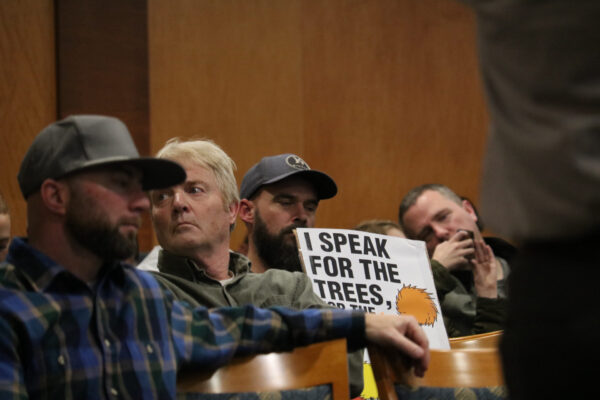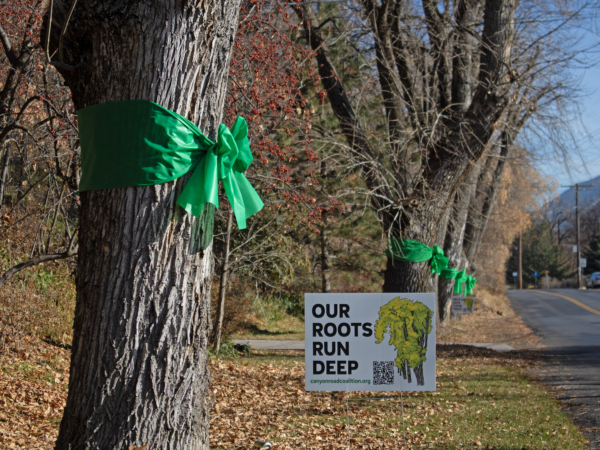Logan community fights to save 100-year-old trees threatened by pipeline project
Editors note: This story was updated on Dec. 5 to reflect new information.
Brandon Elwood speaks for the trees with other residents living near Logan’s historic Canyon Road in a fight against a project that would remove century-old ash trees from the island neighborhood.
When informed of the project, locals united against the cause, tying green ribbons around their tree trunks and spreading the word with signs at popular locations throughout Logan. The Canyon Road Coalition was born through a shared hope that the trees could be saved.
Spearheading the effort is Elwood, a resident of the affected area who hopes the effort will change the minds of the Logan City Council.
As of Thursday, Dec. 5, the petition to oppose the Canyon Road waterline project has over 3,800 signatures, which Elwood said is more votes than most members of the Logan City Council received for their positions.
“We love Logan and live here because of the character of the city,” Elwood said. “The trees, rivers, natural landscapes — we want to see that Logan for future generations.”
The proposed project comes as a result of a state requirement to store additional water along with the growing population in Logan. The city is working with J-U-B Engineers to work on the plans.
In response to public outcry, a public meeting was held at the Logan City Hall on Dec. 5 to discuss the pipeline plans and address resident concerns.

Around 130 Logan residents, including Utah State University students, attended the public meeting. As people filed into the meeting, “save the canyon trees” buttons and flyers were passed out by the Canyon Road Coalition. A few people held signs as they sat in attendance.
The meeting began with project contributors presenting a breakdown of the proposal, then city officials and J-U-B representatives took questions from those in attendance about everything from cost to alternate solutions.
One attendee asked if the city has considered leaving out the proposed sidewalk to leave room for the tree roots.
“That’s definitely an option,” said Zan Murray, a J-U-B engineer working on the project. “It could, but it doesn’t help to accomplish the other master plans that have been developed for the city.”
The atmosphere became tense when questions were raised about whether the Canyon Road route for the pipeline has been selected.
“We have selected our preferred route, and the money has been approved,” said Paul Lindhardt, Logan City’s public works director.
Despite the efforts to quell concerns, many of the attendees expressed dissatisfaction and frustration.
“Our ask of city officials is to pause the project, reevaluate, to come together as a community to provide input and come together on a solution,” Elwood said.

Elwood, who doesn’t normally get involved with civic engagement, said the proposed project woke him up to many large-scale plans that will change the character of the city.
The community has questions about the waterline project, which is set to start in the spring, asking if the fast development of Logan is outpacing what can be done sustainably.
USU students have taken action by passing out flyers and wearing buttons in support of the effort. Elwood said students who live in the island area or visit to connect with nature through recreation will be negatively affected by the loss of the ash trees. Concerned locals have been spreading the word on USU campus to make students aware and encourage them to sign the petition.
As reported by The Salt Lake Tribune, the Logan City Council said the project would help keep children safe by installing sidewalks and mitigating trip hazards while installing the waterline, but residents have voiced apprehension.
“The city decided they know better than the people that live here,” said Alex Gerber, a resident of the affected area. “The city is trying to put in a water pipeline to get water to the west side of the city, but this route they chose just happens to be the shortest and least expensive option.”
According to Gerber, the 17 trees that would need to be removed add charm to the Logan Historic District, and harming them would be disastrous. Gerber said she is concerned about the city’s lack of communication with the locals.
“[The trees] provide shelter to the homes along Canyon Road and to the animals that live there — the squirrels and birds and wildlife,” Gerber said.
Elwood and Gerber encouraged USU students to attend the public meeting on Dec. 5 to show support.
“This seems to be something that impacts everyone,” Elwood said.

